Imagine having a beautiful, low-maintenance plant in your home that not only purifies the air but also adds a touch of elegance to your space. The calathea plant is a popular choice for indoor gardens, and for good reason. With its stunning foliage and unique characteristics, it’s a great way to enhance your home decor and create a more engaging workspace environment. By learning about calathea care and exploring the different calathea varieties, you can bring the beauty of nature into your home and enjoy the many benefits that come with it.

As you consider adding a calathea plant to your home, you’ll want to learn about the best ways to care for it. From watering and fertilizing to pruning and propagating, understanding the needs of your calathea plant will help you keep it healthy and thriving. With the right calathea care, you can enjoy the many benefits of having a calathea plant in your home, including improved air quality, reduced stress levels, and increased focus and productivity.
Table of Contents
Introduction to Calathea Plants
Calathea plants are a popular choice for indoor spaces, and for good reason. With over 300 known species, each with unique characteristics, you can find the perfect calathea indoor plant to suit your style and preferences. To get the most out of your calathea, it’s essential to understand how to care for calathea plant and provide the right conditions for it to thrive.
Native to Brazil, calathea plants are known for their air-purifying qualities, making them a great addition to any home. They can filter pollutants from the air, including formaldehyde, benzene, and trichloroethylene, promoting a healthier living environment. With proper care, your calathea indoor plant can become a beautiful and functional part of your space.

What are Calathea Plants?
Calathea plants are a type of flowering plant that belongs to the Marantaceae family. They are known for their striking foliage, which can range in color from deep greens to vibrant pinks and whites. To keep your calathea plant happy and healthy, it’s crucial to learn how to care for calathea plant, including providing the right amount of light, water, and nutrients.
Origins and Natural Habitat
In their natural habitat, calathea plants thrive in the warm, humid climates of Brazil. They typically grow in shaded areas, where the light is indirect and the temperature is consistent. To replicate these conditions in your home, choose a spot with bright, indirect light and maintain a consistent temperature between 18 and 24 degrees Celsius. By understanding the origins and natural habitat of calathea plants, you can create an ideal environment for your calathea indoor plant to flourish.
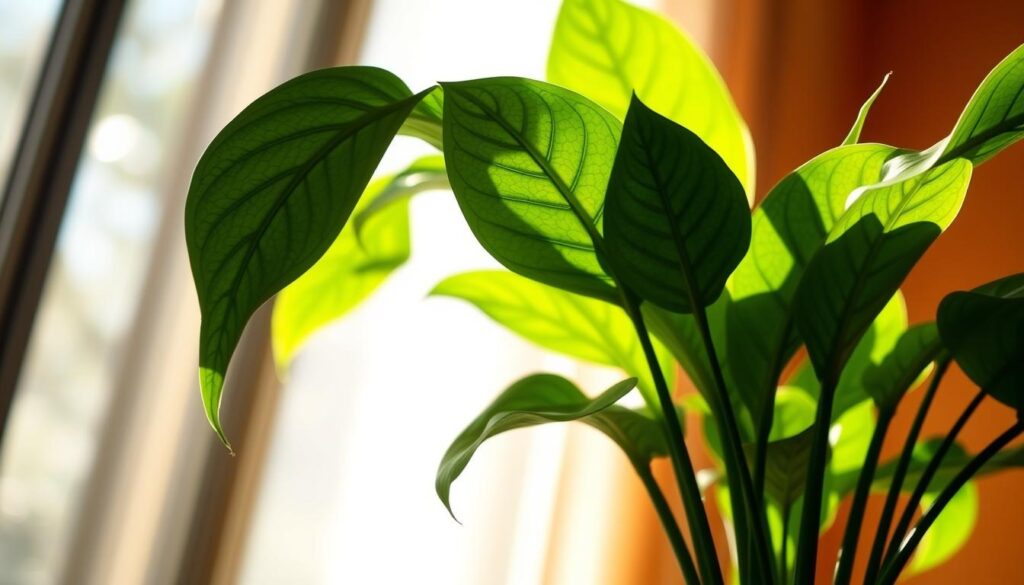
By following these tips and learning how to care for calathea plant, you can enjoy the many benefits of having a calathea indoor plant in your home. From air purification to stress reduction, calathea plants are a great choice for anyone looking to add some greenery to their space.
Stunning Varieties of Calathea
With over 60 species, the Calathea genus offers a wide range of stunning varieties to choose from. You can opt for the calathea ornata, known for its beautiful leaf patterns, or the calathea medallion, which features striking patterns and vibrant foliage. Another popular variety is the calathea zebrina, recognized by its unique zebra-like stripes.
Some other notable varieties include the Calathea Orbifolia, Calathea Rattlesnake, and Calathea Lancifolia. Each variety has its unique characteristics, such as leaf shape, color, and pattern. Whether you’re a seasoned plant enthusiast or a beginner, there’s a Calathea variety to suit your taste and preferences.
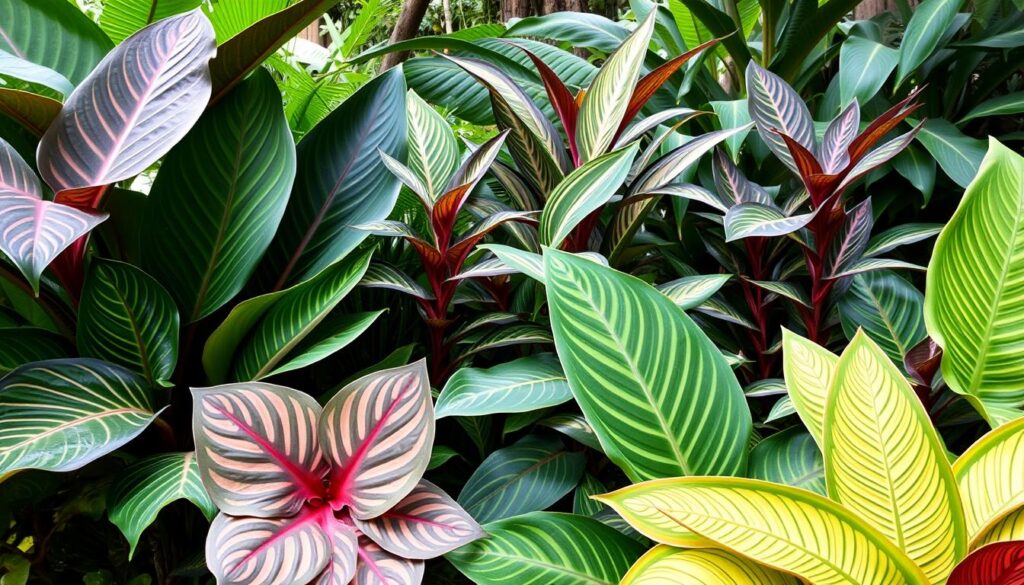
- Calathea Orbifolia: known for its large, round leaves with unique patterns
- Calathea Rattlesnake: features long, narrow leaves with a rattlesnake-like pattern
- Calathea Lancifolia: recognized by its lance-shaped leaves with beautiful markings
By choosing a Calathea variety that suits your style and preferences, you can add a touch of elegance and beauty to your home. With proper care and attention, your Calathea plant will thrive and become a stunning addition to your indoor space.
| Calathea Variety | Leaf Shape | Leaf Color |
|---|---|---|
| Calathea Orbifolia | Round | Green with unique patterns |
| Calathea Rattlesnake | Long and narrow | Green with rattlesnake-like pattern |
| Calathea Lancifolia | Lance-shaped | Green with beautiful markings |
Ideal Growing Conditions for Calathea
To keep your calathea plant thriving, it’s essential to replicate its natural habitat. Calathea plants prefer medium to bright indirect light, but can tolerate low indirect light. When it comes to calathea plant care tips, light requirements are crucial. You should place your calathea in a spot with dappled sunlight, avoiding direct sunlight that can cause leaf scorch.
Calathea care also involves using well-draining potting soil with components such as compost, pine bark, and perlite. This type of soil will help retain moisture and provide nutrients to your plant. In terms of temperature and humidity, calathea plants prefer a humid environment with temperatures between 65°F-85°F (18°C-30°C). You can use a humidifier to maintain the ideal humidity level, which is significantly above 50%.
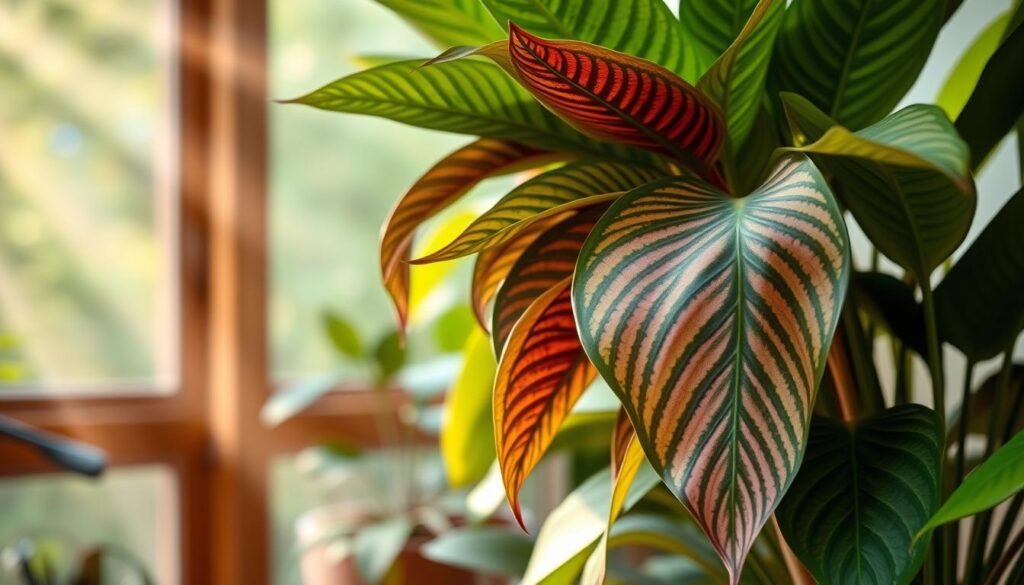
Light Requirements
Calathea plants thrive in medium to bright indirect light, but can tolerate low indirect light. You should place your calathea in a spot with dappled sunlight, avoiding direct sunlight that can cause leaf scorch.
Soil Preferences
Calathea care involves using well-draining potting soil with components such as compost, pine bark, and perlite. This type of soil will help retain moisture and provide nutrients to your plant.
Temperature and Humidity Needs
Calathea plants prefer a humid environment with temperatures between 65°F-85°F (18°C-30°C). You can use a humidifier to maintain the ideal humidity level, which is significantly above 50%. By following these calathea plant care tips, you’ll be able to create an ideal environment for your plant to thrive.
| Factor | Ideal Condition |
|---|---|
| Light | Medium to bright indirect light |
| Soil | Well-draining potting soil with compost, pine bark, and perlite |
| Temperature | 65°F-85°F (18°C-30°C) |
| Humidity | Significantly above 50% |
Watering Your Calathea Plant
When it comes to caring for your calathea indoor plant, watering is a crucial aspect to consider. To keep your plant healthy and thriving, it’s essential to understand how to care for calathea plant, including its watering needs. Calatheas require watering once or twice a week, depending on the dryness of the soil. It’s recommended to test the soil moisture by inserting your finger into the soil up to the first knuckle.
A key factor in determining the watering frequency is the environment in which your calathea indoor plant is placed. If the plant is in a warm and humid spot, it may require more frequent watering. On the other hand, if the plant is in a cooler and drier spot, it may require less frequent watering. To maintain the right level of humidity, you can mist your calathea plant every few days.
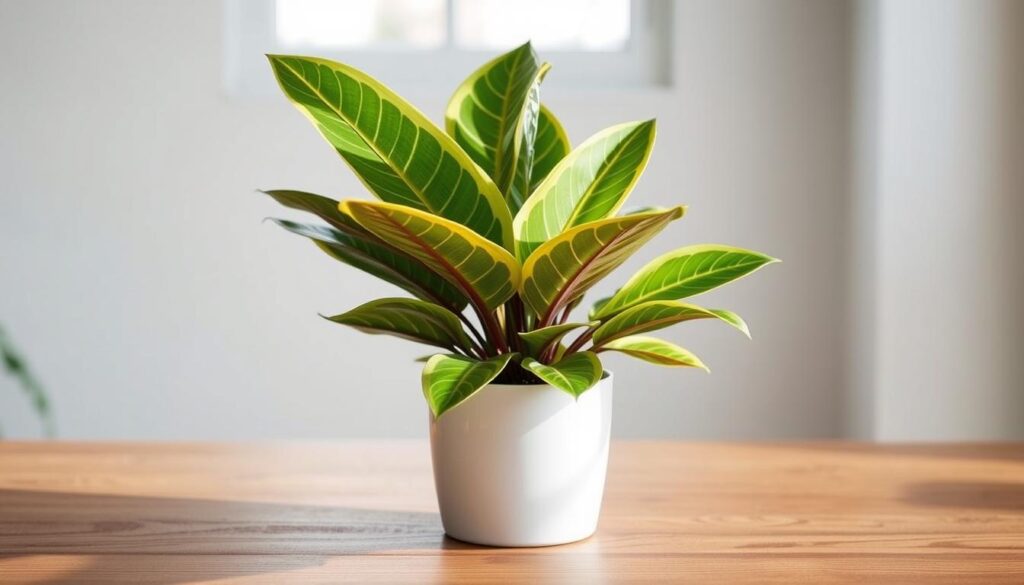
Here are some signs to look out for to determine if your calathea plant is receiving the right amount of water:
- Yellowing leaves: This can be a sign of overwatering.
- Brown leaves: This can be a sign of underwatering.
- Droopy stems: This can be a sign of both overwatering and underwatering.
By following these guidelines and understanding how to care for calathea plant, you can ensure your calathea indoor plant remains healthy and thriving. Remember to water your calathea plant carefully, as it can be sensitive to overwatering and underwatering.
| Watering Frequency | Soil Moisture | Environment |
|---|---|---|
| Once a week | Dry to the touch | Warm and humid |
| Twice a week | Moderately moist | Cool and dry |
Fertilizing Calathea Plants
As you continue to care for your Calathea plant, fertilization is a crucial step to promote healthy growth and vibrant foliage. When it comes to calathea plant care tips, fertilizing is essential to provide your plant with the necessary nutrients. To ensure proper calathea care, you should fertilize your plant regularly.
Young, fast-growing Calathea plants require more frequent fertilization compared to slower-growing, mature plants. The recommended fertilization frequency is once a month during spring and summer for liquid fertilizers. Granular fertilizers should be mixed into the soil every six months.
Types of Fertilizers to Use
There are several types of fertilizers you can use for your Calathea plant. Fertilizers with a balanced nutrient ratio, such as 10:10:10 or 3:1:2, are recommended. Organic fertilizers, like worm castings, provide a steady nutrient supply without the risk of over-fertilization. Synthetic fertilizers with a balanced ratio, such as 10-10-10 or 20-20-20, provide quick nutrients for growth.
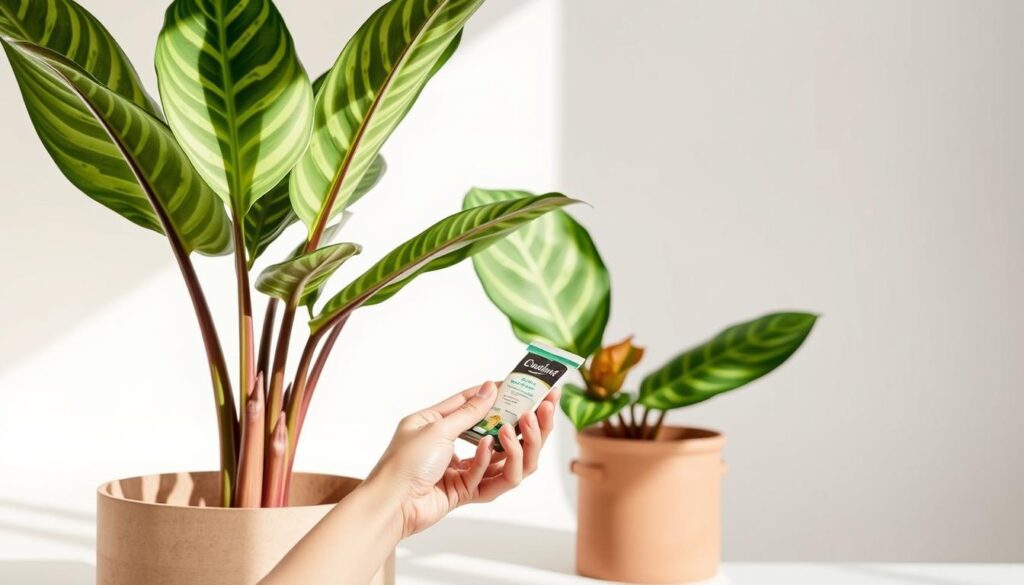
Frequency of Fertilization
The frequency of fertilization depends on the time of year and the type of fertilizer used. During the active growing season (spring and summer), fertilize your Calathea plant every 2 to 4 weeks. In the fall and winter, when the plant is dormant, you can reduce the fertilization frequency to once every three months.
Remember to choose a fertilizer that is suitable for your Calathea plant’s needs, and follow the instructions on the label for proper application. With proper fertilization and calathea care, your plant will thrive and provide you with beautiful, vibrant foliage.
| Fertilizer Type | Frequency |
|---|---|
| Liquid Fertilizers | Once a month (spring and summer) |
| Granular Fertilizers | Every six months |
| Organic Fertilizers | As needed |
Common Pest Problems
As a calathea plant owner, you should be aware of the common pest problems that can affect your plant. Calathea care involves being vigilant about potential pests, such as spider mites, mealybugs, and scale insects, which can cause damage to your plant’s leaves and overall health.
Some common signs of pest infestations include stippling, fine webbing, and discoloration on the leaves. If left unchecked, these pests can lead to premature leaf drop, yellowing, and stunted growth. Regular inspections of your calathea plant, especially on the undersides of leaves, can help you detect pest problems early on.
To prevent pest infestations, it’s essential to maintain good calathea care habits, such as keeping the soil consistently moist but not waterlogged, and providing optimal humidity levels. You can also introduce beneficial insects, like ladybugs and lacewings, to naturally control pest populations.
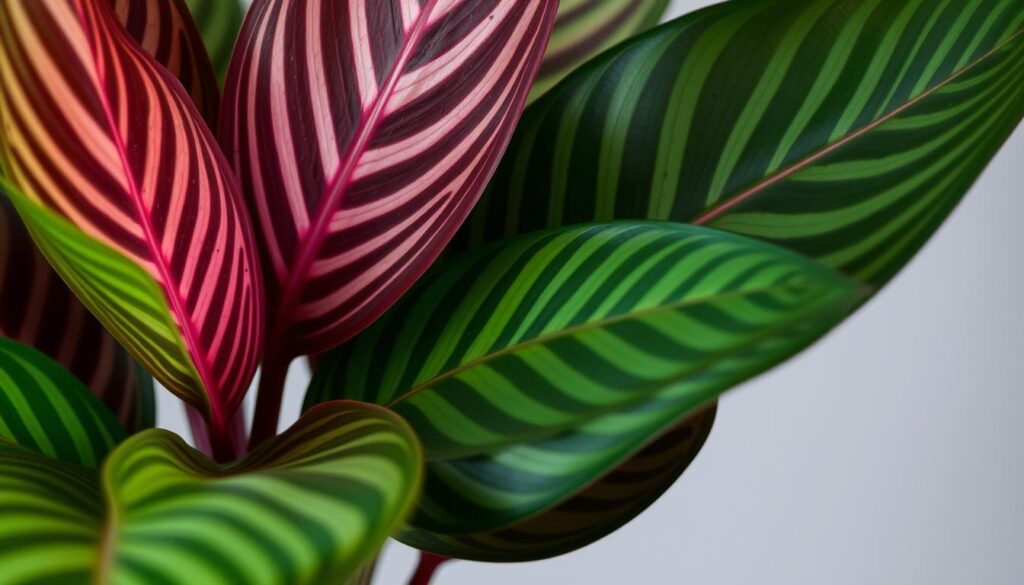
Some natural pest control solutions include using insecticidal soaps and neem oil, which can be applied cautiously to avoid harming beneficial insects. Quarantining new plants for at least two weeks can also help prevent introducing pests into your existing plant collection.
Identifying Pests
- Spider mites: look for sticky webbing and fine stippling on leaves
- Mealybugs: check for white, cottony masses on the plant
- Scale insects: inspect for yellowing leaves and stunted growth
Natural Pest Control Solutions
By following these tips and maintaining good calathea care habits, you can help prevent pest infestations and keep your calathea plant healthy and thriving.
Propagation Techniques
When it comes to calathea plant care tips, propagation is an essential aspect to consider. Calathea care involves understanding the best methods for propagating these beautiful plants. One of the most effective ways to propagate calathea is through division, which is best suited for mature plants with multiple stems. The ideal time for division is early spring, providing a full growing season for establishment.
Another method for propagating calathea is by using leaf cuttings. Healthy stem cuttings should be about 4-6 inches long and contain at least two sets of leaves. Utilizing rooting hormone can significantly boost root development during stem cutting propagation. It’s also important to maintain high humidity levels, between 40-60%, to mimic tropical conditions.

- Maintaining optimal temperature range between 60°F and 70°F
- Providing bright, indirect light
- Watering carefully to avoid overwatering, which can lead to root rot
- Using a well-draining soil mix, such as two-thirds peat moss and one-third perlite
By following these calathea plant care tips and understanding the best propagation techniques, you can successfully grow and care for your calathea plants, enjoying their beautiful foliage and vibrant colors.
Troubleshooting Common Issues
As a calathea indoor plant owner, you may encounter some common issues that can affect the health and appearance of your plant. To keep your calathea thriving, it’s essential to learn how to care for calathea plant and identify potential problems early on. Yellowing leaves and leaf browning are two of the most common issues that can affect calathea plants.
Yellowing leaves can be caused by overwatering, natural leaf shedding, overexposure to sunlight, or changes in growing conditions. On the other hand, leaf browning can be caused by low humidity, underwatering, or exposure to cold temperatures. To prevent these issues, make sure to maintain a consistent watering schedule, provide your calathea with bright, indirect light, and keep the temperature between 15°C to 21°C.
Here are some tips to help you troubleshoot common issues with your calathea indoor plant:
- Check the soil moisture regularly to avoid overwatering or underwatering.
- Provide your calathea with high humidity, ideally between 50-70%.
- Use filtered or rainwater instead of tap water to prevent mineral buildup in the soil.
- Fertilize your calathea regularly, using a balanced, water-soluble fertilizer.
By following these tips and learning how to care for calathea plant, you can keep your calathea indoor plant healthy and thriving. Remember to monitor your plant regularly and take action promptly if you notice any signs of trouble.
| Common Issue | Cause | Solution |
|---|---|---|
| Yellowing leaves | Overwatering, natural leaf shedding, overexposure to sunlight, or changes in growing conditions | Adjust watering schedule, provide bright, indirect light, and maintain consistent growing conditions |
| Leaf browning | Low humidity, underwatering, or exposure to cold temperatures | Increase humidity, adjust watering schedule, and keep temperature between 15°C to 21°C |
Decorating with Calathea
When it comes to decorating with your calathea plant, the key is to find the right location in your home where it can thrive and add a touch of nature’s artistry to the space. Calathea care involves understanding the plant’s preferences for medium to low light, making it an ideal choice for rooms with limited natural light.
Some of the best locations for your calathea plant include a cozy reading nook, a peaceful bedroom, or a serene bathroom. To add a creative touch to your decor, consider the following display ideas:
- Place your calathea plant on a decorative planter or pot to add a pop of color and texture to the room.
- Use a plant stand to elevate your calathea plant and create a sense of depth in the room.
- Combine your calathea plant with other plants or decorative items to create a unique and visually appealing display.
By following these tips and understanding the basics of calathea care, you can create a beautiful and thriving indoor space that showcases your calathea plant in all its glory. With its stunning foliage and low-maintenance requirements, the calathea plant is the perfect addition to any home, and with the right decor, it can become a stunning focal point in any room.
Remember, the key to successful calathea care is to provide your plant with the right environment and attention. By doing so, you can enjoy the beauty and benefits of your calathea plant for years to come.
| Calathea Plant Variety | Lighting Requirements | Watering Frequency |
|---|---|---|
| Calathea Orbifolia | Medium to low light | Weekly |
| Calathea Medallion | Low light | Every 10 days |
| Calathea Rattlesnake | Medium light | Every 7 days |
Conclusion: Why Choose Calathea?
As you’ve discovered, the Calathea plant is a remarkable addition to any home. Not only does it offer stunning visual appeal with its vibrant foliage, but it also provides practical benefits that enhance your living space. From its air-purifying capabilities to its natural humidifying effects, the Calathea is a true asset.
Benefits of Calathea in Home Décor
The Calathea plant‘s unique leaf-folding habit and diverse variety of patterns and colors make it a captivating centerpiece in any room. Whether you choose the striking Calathea Peacock or the elegant Calathea Whitestar, these plants can effortlessly elevate your home décor, serving as natural conversation starters.
Final Thoughts on Caring for Calathea Plants
While Calathea plant care may require a bit more attention than some other houseplants, the rewards are well worth it. With the right Calathea care tips, such as maintaining consistent moisture and humidity, you can enjoy the long-lasting beauty and practical benefits of these remarkable plants. Bring the tranquility of nature into your home and let the Calathea transform your living space.
FAQ
What are Calathea plants?
Calathea plants are a group of tropical foliage plants known for their vibrant, eye-catching leaves. They are native to the Americas and can thrive indoors, making them a popular choice for home decor.
What are the benefits of having a Calathea plant in my home?
Calathea plants are effective air purifiers, removing toxins from the air and promoting a healthier living environment. They can also add instant visual interest to any room with their large, bold leaves and striking patterns.
What are some popular varieties of Calathea plants?
Some of the most popular Calathea varieties include the Calathea Orbifolia, Calathea Medallion, and Calathea Rattlesnake. Each variety has its own unique characteristics and foliage patterns.
What are the ideal growing conditions for Calathea plants?
Calathea plants prefer bright, indirect light, well-draining soil, and consistent humidity levels. They do not like direct sunlight and thrive in shaded corners of your home.
How often should I water my Calathea plant?
Maintaining a consistent watering schedule is crucial for Calathea plants. They prefer to have their soil moist but not waterlogged. Underwatering can lead to dramatic consequences, such as drooping leaves and stems.
Do Calathea plants require fertilization?
Yes, Calathea plants benefit from occasional fertilization to support their growth and maintain vibrant foliage. Choose a balanced, diluted fertilizer and apply it according to the manufacturer’s instructions.
What are some common pest problems that can affect Calathea plants?
Calathea plants may be susceptible to pests such as spider mites, mealybugs, and scale insects. Regular monitoring and the use of natural pest control solutions can help prevent and treat these issues.
How can I propagate my Calathea plant?
Calathea plants can be propagated through leaf cuttings or division. This is a great way to create new plants and share your Calathea with friends and family.
What are some common issues that can affect Calathea plants?
Calathea plants may experience issues such as yellowing leaves or leaf browning, which can be caused by factors like underwatering, overwatering, or environmental stress. Proper care and troubleshooting can help address these problems.
How can I display my Calathea plant in my home?
Calathea plants can be showcased in various ways, such as placing them in brightly lit, shaded corners or incorporating them into creative displays. Their eye-catching foliage can elevate the visual appeal of any room.
Source Links
- 8 Benefits of Calathea Plants: A Beautiful Addition to Your Home – https://www.ugaoo.com/blogs/gardening-basics/8-benefits-of-having-a-calathea-plant-in-your-home?srsltid=AfmBOoqsghxSBxq29-NFf1CHLR1JW7lzQuetixukaYuRJH2ZUCI_IA_P
- How To Grow And Care For Low-Maintenance Calatheas – https://www.southernliving.com/garden/indoors/calathea-plant-care?srsltid=AfmBOoqs6q0r6FoxSkjmixAhMPAuzE_ZfhLfcHb7J2KKLIicJREoLrqT
- The Fascinating World of Calathea Plants: An Introduction – https://be.green/en/blog/the-fascinating-world-calathea-plants-introduction?srsltid=AfmBOop2-AXpk8OHBn3bACssgIuwaXjLgt4D12PFamtd2R4sZaotJ9S1
- Plant profile: Calathea – https://plantcircle.com/blogs/guides/plant-profile-calathea?srsltid=AfmBOooBEejQnvBhBB06zL2mwHxlU_gQ7DakwrC7KZ989webZMSV3KOb
- 41 Calathea Varieties to Grow at Home – https://www.thespruce.com/calathea-varieties-7371359
- Calathea Varieties: 43 Different Types of Calathea Plants – https://www.epicgardening.com/calathea-varieties/
- How To Care for a Calathea Plant – The Sill – https://www.thesill.com/blogs/plants-101/how-to-care-for-calathea?srsltid=AfmBOoqwU1pBEGHa0i3kqH5fFhIkx7YnKDyTIW2fZRaBFJAAU3VTYbuc
- How to Grow and Care for Calathea – https://www.thespruce.com/grow-calathea-indoors-1902745
- The Ultimate Guide To Watering Your Calathea — Plant Care Tips and More · La Résidence – https://blog.leonandgeorge.com/posts/calathea-care-watering-guide
- Calathea – https://www.leafenvy.co.uk/blogs/plant-a-z/calathea?srsltid=AfmBOoojrbYJNCy_qPnonrfvB9dCs5lUoQ5rC4tGauQDot-SNjaQ5Lco
- calathea Plant Care: Water, Light, Nutrients | Greg App 🌱 – https://greg.app/plant-care/calathea-pink-lady-calathea
- How Often To Fertilize Calathea? – https://greg.app/how-often-to-fertilize-calathea/
- Fertilizing Calathea | Plant Addicts – https://plantaddicts.com/fertilizing-calathea/?srsltid=AfmBOookDqSe6CN5nV77U8GI2rEndgBN9gt6W-zeXAUROdSQKnFMRwrz
- 🐛 What Are The Bugs on My Pinstripe Calathea? – https://greg.app/bugs-on-pinstripe-calathea/
- 11 Common Problems With Calathea Plants – https://www.epicgardening.com/calathea-problems/
- How to Save Your Calatheas from Winter Cold and Pests | Salisbury Greenhouse – https://salisburygreenhouse.com/save-your-calatheas-from-winter-cold-and-pests/
- How to Propagate Your Calathea Musaica – https://greg.app/propagate-calathea-musaica/
- Calathea Propagation Methods: How To Propagate Calathea Plants – https://www.gardeningknowhow.com/houseplants/calathea-plants/calathea-propagation.htm
- Flora | Calathea Propagation Techniques: Tips for Success – https://florasense.com/blogs/calathea-propagation-techniques-tips-for-success/
- Calathea Plants Care Instructions – Keep them Looking Great! – https://plantify.co.za/pages/calathea-plants-care-instructions?srsltid=AfmBOopxRB27eAaU3Ta31ijU5gPkzK-oyNpkApwXIvvn5HYzqd4pfvJD
- Why Is My Calathea Dying | Common Problems | Plants for all Seasons – https://www.plantsforallseasons.co.uk/blogs/calathea-care/why-is-my-calathea-dying-common-problems-and-how-to-fix-them
- Calathea Houseplant Care: Essential Troubleshooting Tips and Popular V – https://www.generosanature.com/fr-es/blogs/plant-library/calathea-houseplant-care-essential-troubleshooting-tips-and-popular-varieties?srsltid=AfmBOor4qEVq2DNWM0U_ojVlYNHTM3mdNny5mCKefkVKs3Tjsbd1UrUz
- Decorating with Pachira, Calathea or Kentia plants: a practical guide – https://be.green/en/blog/decorating-with-pachira-calathea-kentia-plants-practical-guide?srsltid=AfmBOooPIHOQuDwDpcg9JbMdTw-LRx7Opm8OAVObf5oh_9_e2mo0BF7E
- How to Grow Colorful Calathea Plants – Garden Design – https://www.gardendesign.com/houseplants/calathea.html
- How to Care for Calathea Plants – Garden and Plant Care – https://growitmobile.com/plants/calathea/
- 8 Benefits of Calathea Plants: A Beautiful Addition to Your Home – https://www.ugaoo.com/blogs/gardening-basics/8-benefits-of-having-a-calathea-plant-in-your-home?srsltid=AfmBOoqJE76y7O7YctEhXksKS7uZR9XwvY9WkdbB4mLK6vx7NyRgcJ-m
- Benefits of Having a Calathea Plant- Health & Vastu Benefits – https://greenkin.in/blogs/plant-talk/benefits-of-having-a-calathea-plant?srsltid=AfmBOoojmhSz9cJM-t-85EpFO6fwpVY2crxzL2VIRhyPdeEaeemjCmpQ
- Calathea: Botanical Elegance for Your Home Oasis – https://plantologyusa.com/blogs/the-plantologist/calathea-botanical-elegance-for-your-home-oasis?srsltid=AfmBOorwPpss-qdR8EQ5YaPcwpQyqmKMEzgU6z2JfXPLiqxJGcwGcF_5

